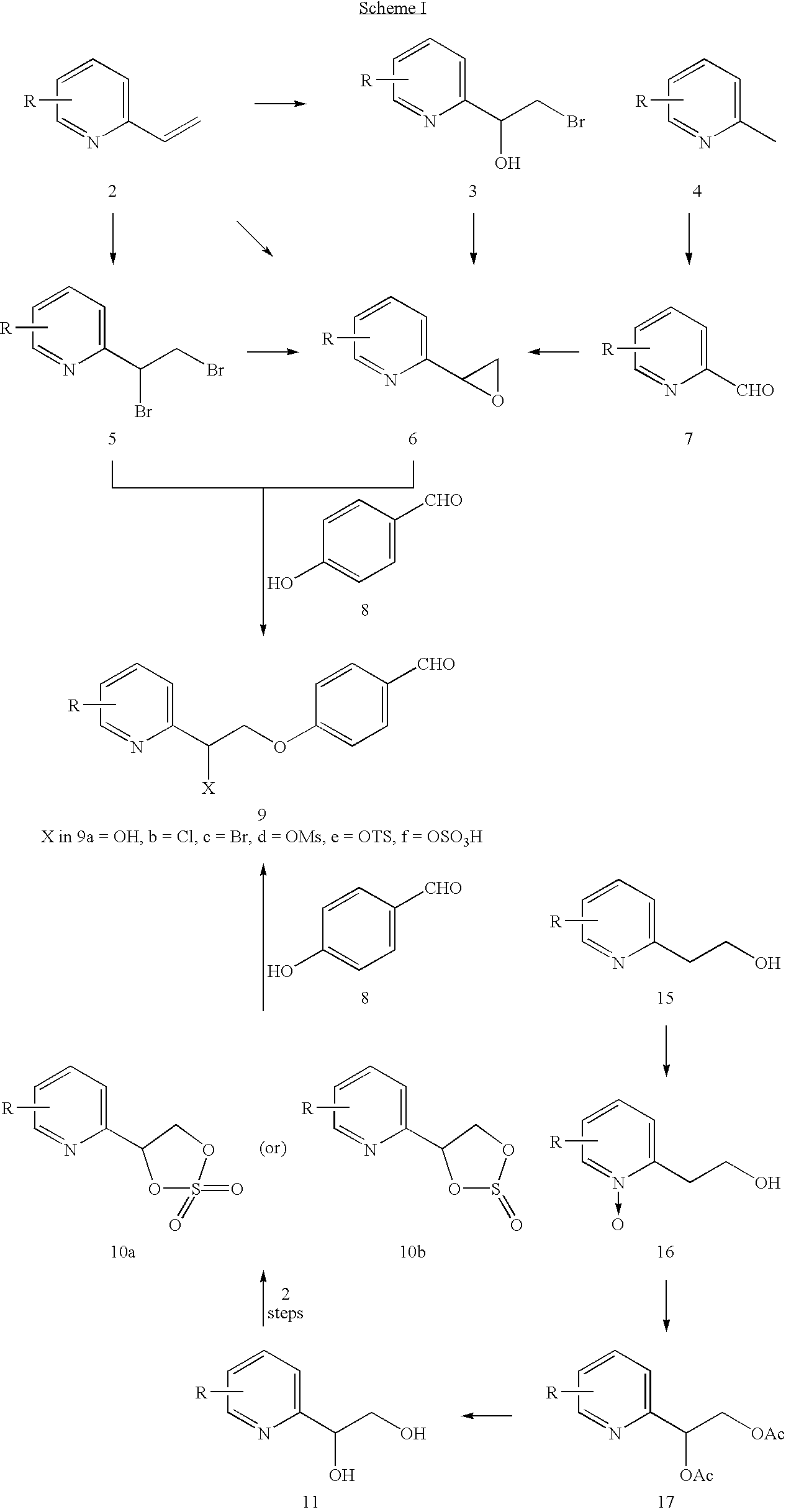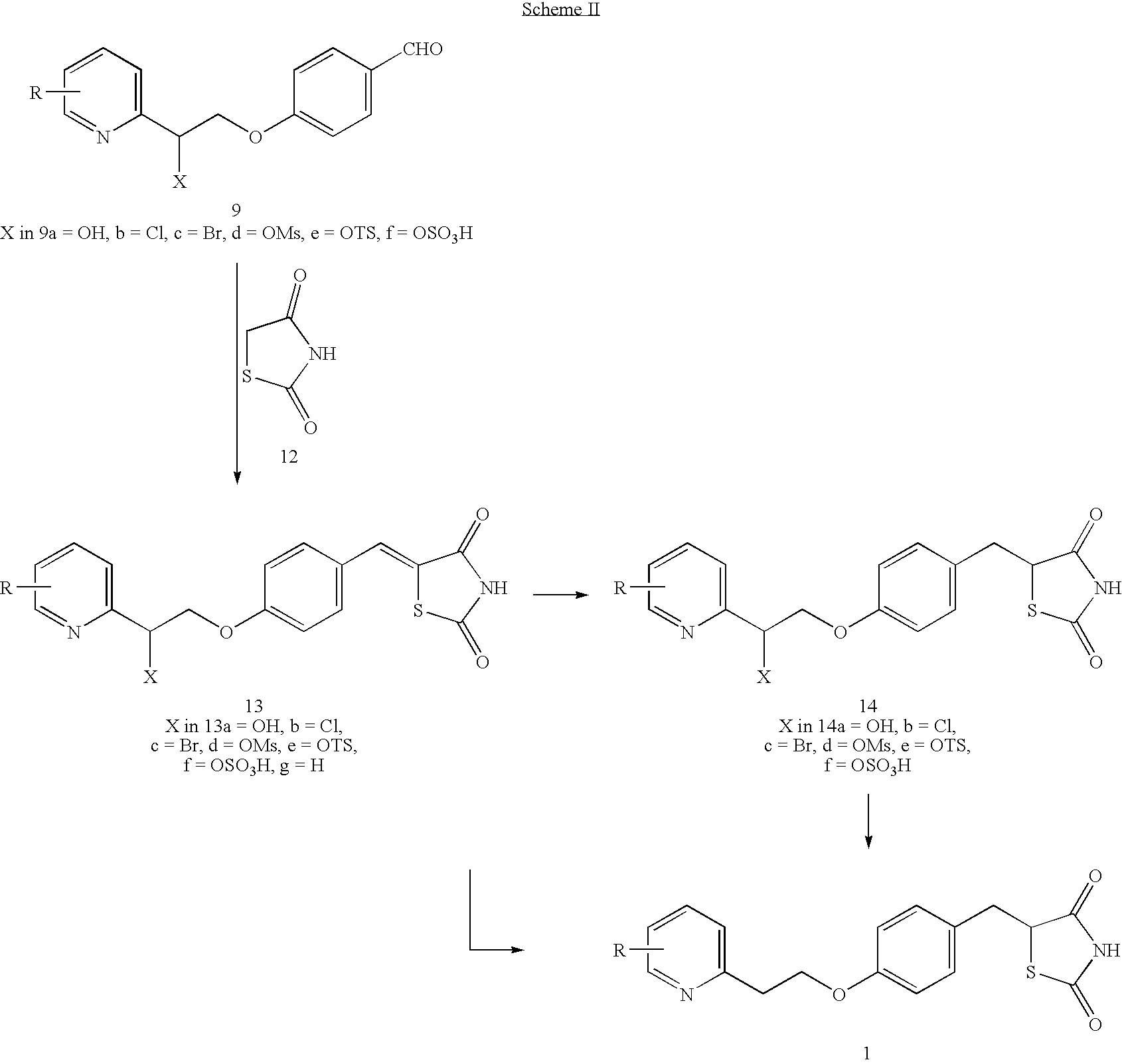Novel process to prepare pioglitazone via several novel intermediates
a technology of pioglitazone and intermediates, which is applied in the field of novel intermediate preparation of pioglitazone, can solve the problems of difficult control of the meerwein reaction at industrial level, aggravate impaired glucose tolerance and insulin resistance, and frank diabetes, and achieves improved commercial viability, high yield, and operation simple
- Summary
- Abstract
- Description
- Claims
- Application Information
AI Technical Summary
Benefits of technology
Problems solved by technology
Method used
Image
Examples
example 1
2-Bromo-1-(5-ethyl pyridin-2-yl)ethanol (3)
[0033] To a stirred mixture of 225 mL 1,4-dioxane and 225 mL water, 75 g (0.5639 mol) of 5-ethyl-2-vinyl-pyridine was added, followed by 149 g (0.8371 mol) N-bromosuccinimide was added in to it. Reaction mixture was stirred at 25-30° C. for 4 hr. and subsequently quenched with excess water. Product was extracted with dichloromethane. Organic layer was separated and dried over calcium chloride. On concentrating the organic layer and purifying the residue, it gave 110.24 g (85%) of desired product.
[0034] The product obtained was characterized by IR, Mass, 13C NMR, and 1H NMR, which are as given below.
[0035] IR spectrum (cm−1): 3200 (O—H str.), 1085 (C—O Str.), 715 (C—Br str.)
[0036] Mass spectrum (m / z): 230.1 (M)+
[0037]13C-NMR (DMSO-d6): δ 153.38, 145.33, 142.35, 140.40, 124.40, 68.29, 38.11, 24.60, 14.56
[0038]1H-NMR (DMSO-d6): δ 8.03-8.68 (3H, m), 5.37 (1H, t), 3.91 (2H, d), 2.76 (2H, q), 1.22 (3H, t)
example 2
2-Bromo-1-(5-ethyl pyridin-2-yl)-ethanol (3)
[0039] To a solution at −5° C., of 50 g (0.3759 mol) 5-ethyl-2-vinyl-pyridine dissolved in a mixture of 2504 mL dimethylsulfoxide and 13.5 mL water was added 99.3 g (0.5578 mole) N-bromosuccinimide and stirring was continued for 30 min. at 0 to −5° C. Reaction mixture was quenched with 2500 mL water and the product was extracted with dichloromethane. Organic layer was dried (calcium chloride); concentrated and purified to get the desired product. Yield of the product was 76.09 g (88%). The two side products in this reaction found were 2-acetyl-5-ethyl-pyridine (5%) and 2-(1-bromo vinyl)-5-ethyl-pyridine (6%).
[0040] The product obtained was characterized by IR, Mass, 13C NMR and 1H No, which was found to be identical with the product obtained in example 1.
example 3
2-Bromo-1-(5-ethyl pyridin-2-yl)-ethanol (3)
[0041] 5.5 g (0.0344 mol) liq. Bromine was added to a solution of 7.83 g (0.0658 mol) KBr dissolved in 100 mL water. Reaction mixture was heated to 60-65° C. and 5 g (0.0376 mol) of 5-ethyl-2-vinyl-pyridine was added into it in 10 min. Reaction mixture was stirred for 30 min. and quenched with excess of water. Product was extracted with dichloromethane, which was separated, dried, concentrated and purified to get 7.43 g (86%) of the titled product.
[0042] The product obtained was characterized by IR, Mass, 13C NMR and 1H NMR, which was found to be identical with the product obtained in example 1.
PUM
| Property | Measurement | Unit |
|---|---|---|
| molar ratio | aaaaa | aaaaa |
| molar ratio | aaaaa | aaaaa |
| molar ratio | aaaaa | aaaaa |
Abstract
Description
Claims
Application Information
 Login to View More
Login to View More - R&D
- Intellectual Property
- Life Sciences
- Materials
- Tech Scout
- Unparalleled Data Quality
- Higher Quality Content
- 60% Fewer Hallucinations
Browse by: Latest US Patents, China's latest patents, Technical Efficacy Thesaurus, Application Domain, Technology Topic, Popular Technical Reports.
© 2025 PatSnap. All rights reserved.Legal|Privacy policy|Modern Slavery Act Transparency Statement|Sitemap|About US| Contact US: help@patsnap.com



